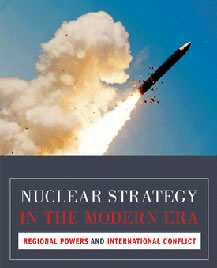
Vipin Narang is an associate professor of political science at MIT and member of MIT's Security Studies Program.
An excerpt from his book Nuclear Strategy in the Modern Era: Regional Powers and International Conflict.
Reprinted with permission by Princeton University Press, 2014: pp. 8–12.
THE ARGUMENT IN BRIEF
LARGELY FORGOTTEN in the scholarly and policy obsession with the Cold War and with nuclear acquisition is the fact that regional powers have chosen different nuclear strategies. These differences matter greatly to their ability to deter conflict. I take these issues in turn. The first part of the book asks: which nuclear postures have regional powers adopted, and why? I begin in chapter 2 by identifying the diverse nuclear postures adopted by the regional powers, using original data collected from the field, and then develop a new theory for their selection. I classify and characterize three possible regional power nuclear postures, arrayed across a spectrum of capabilities and deployment options.
- A catalytic posture, which consists of only a handful of nuclear weapons, threatens the explicit breakout of nuclear weapons in the event the state’s survival is threated in order to compel—or catalyze—third party intervention on the state’s behalf. For example, Israel and South Africa adopted this posture for a significant portion of their nuclear histories.
- An assured retaliation posture involves the development of secure second strike capabilities that enable a state to threaten certain nuclear retaliation should it suffer primarily a nuclear attack. This posture has been adopted by India and China.
- An asymmetric escalation posture develops capabilities and procedures that credibly enable the rapid and first use of nuclear weapons in the event of a conventional attack. France and Pakistan have each, at some point, adopted this posture.
Given these three alternative nuclear postures, why might states select one over the others? Current alternative theories in international relations that may explain a state’s nuclear posture—security environment, technological determinism, and strategic culture—are unsatisfactory and often indeterminate. Therefore, I propose a novel theory of the sources of nuclear posture: Posture Optimization Theory, or optimization theory for short. Taking inspiration from the neoclassical realist school of international relations theory, it explains how and why a regional power might select and optimize its nuclear posture in response to external security and internal domestic political and financial constraints. It offers a determinate prediction for a state’s nuclear posture based on several clearly identifiable and sequential variables. A state’s security environment—the availability of powerful allies and the severity of its immediate threats—is critical and, indeed, the primary variable responsible for nuclear postures. But where that security environment is permissive, as is often the case, states have a range of choice in nuclear postures. Other considerations at the domestic level, such as civil–military relations and resource constraints, regulate a state’s choice of nuclear posture. For example, the asymmetric escalation posture is not only financially and organizationally demanding, but it forces a state’s leadership to be prepared to devolve nuclear assets and authority to military end users in order to maintain the credibility of first use options. This increases the risk of unauthorized and accidental use of nuclear weapons and can impose tremendous strain on a state’s civil–military organs. As such, states with permissive security environments that can opt out of an asymmetric escalation posture may find it rational to do so if adopting this posture is incompatible with other unit–level preferences and constraints—especially those imposed by the configuration of the state’s civil–military relations.

Nuclear Strategy in the Modern Era by Vipin Narang
This theory provides the most valid available framework for why states select the nuclear postures they do, providing testable and falsifiable predictions for the nuclear postures emerging and those that future regional nuclear powers might select in the future, and specifying when and under what conditions existing regional nuclear powers might shift postures. It is important to note that this theory attempts to predict and explain posture outcomes, not necessarily the process or efficiency by which a state adopts a particular posture (which is a separate question demanding a different theory and study).
Chapters 3 through 8 focus in detail on the nuclear postures of each regional power: Pakistan, India, China, France, Israel, and South Africa. For each, I describe the specific nuclear strategy that the regional nuclear power has adopted over time. From an empirical perspective, this discussion on the actual nuclear postures of all the regional powers over time provides the first comparative treatment of all six regional nuclear powers. I then test each state’s choice of nuclear posture against my theory and the three alternative explanations: structural realism, technological determinism, and strategic culture. I analyze whether the form and rationale for each state’s selection is consistent with each of these four theories. For example, I show that Pakistan has shifted from catalytic posture to an asymmetric escalation posture and deploy my theory to explain these choices. Similarly, I offer an explanation for why India, China, and now Israel have all opted for small but secure assured retaliation postures, even though they have the capability to adopt more aggressive strategies.
From a theoretical standpoint, these chapters provide the first broad explanation for why these states have adopted the nuclear postures that they have. They provide a framework that helps theorists and policy makers alike think about the variables that might drive regional powers to adopt a specific nuclear strategy, and understand the conditions under which states might shift strategies. The empirical tests establish the validity of the theory, thereby providing testable predictions for the postures that possible future nuclear states, such as Japan or Iran, might adopt.
The variation in regional power nuclear strategies is only important, however, if there are consequences to the different choices these powers make. Thus, the second part of the book focuses on the ramifications of these choices about nuclear posture for international security. It asks the critical question posed earlier: what kind of nuclear strategy is required to deter conflict? Using both quantitative and qualitative analysis, I find that the mere possession of nuclear weapons fails to systematically deter conventional attacks. Chapter 9 and 10 demonstrate that there are very real differences in the deterrence consequences of these various nuclear strategies: some nuclear postures fail to deliver on their promise to deter conflict. In fact, onlythose states that adopt an asymmetric escalation posture enjoy significant deterrent success against conventional attacks. The catalytic and assured retaliation postures fail to do so because the risk of nuclear use even in intense conventional conflicts is so low that it does not deter opponents from attacking these nuclear powers—sometimes resulting in conflicts of very high intensity.
Chapter 9 conducts a large–n analysis to isolate the average effects of these nuclear postures in reducing armed attacks at various levels of intensity. This analysis illuminates the general deterrence effects of each nuclear posture, providing an estimate of how many fewer attacks a state can expect to experience after adopting a particular nuclear posture. It shows that the asymmetric escalation posture is uniquely "deterrence optimal," reducing conflict at each level of armed intensity against both nuclear and non–nuclear powers. Contrary to conventional wisdom about the deterrence power of possessing any nuclear weapons, states adopting assured retaliation and catalytic postures have experienced serious deterrence failures even at high levels of conventional conflict intensity. The implication is that even secure second–strike nuclear forces may not be sufficient to deter the initiation of full wars against a regional nuclear power. Certainly, nuclear weapons alone are insufficient to reap any significant deterrent effect. These findings fundamentally challenge the assumption that the mere possession of nuclear weapons provides substantial deterrent benefits.
Chapter 10 focuses on the effects of nuclear postures in particular crises. These crises, selected in part based on the large–n analysis in the previous chapter, tease out the mechanisms that connect nuclear posture to deterrence success and failure. I examine a series of crises in enduring rivalries between India and Pakistan, and between Israel and the various Arab states over time. Examining crises in enduring rivalries has the benefit of holding many variables constant in crises where many moving parts would otherwise make it difficult to isolate the effect of nuclear postures. In this chapter, I probe how different nuclear postures have affected states’ decisions to escalate or de–escalate a crisis, measuring differential deterrence effects of postures on both the outbreak and the course of the crisis. I augment the empirical richness of the data on these crises with interviews with key national security decision makers, especially in the India–Pakistan cases. This chapter confirms the findings from the large–n analysis, showing that not only does the asymmetric escalation posture uniquely reduce armed attacks, but decision makers are deterred from attacking an asymmetric escalator because of the fear of nuclear first use. Catalytic postures have resulted in high–intensity wars being waged against states, and even assured retaliation postures have been unable to deter high–intensity wars, such as the 1999 Kargil War launched by Pakistan against India. On the other hand, when Pakistan shifted from a catalytic to an asymmetric escalation posture, it enjoyed a marked increase in deterrence success against India.
Contrary to the conventional wisdom—indeed contrary to a bedrock article of faith in the canon of nuclear deterrence—the acquisition of nuclear weapons does notproduce a uniform deterrent effect against opponents. Despite the arguments of scholars including Kenneth Waltz, Robert Jervis, and John Mearsheimer, the possession of nuclear weapons by itself, and even the adoption of secure second–strike forces, is insufficient to systematically deter conventional conflict. This finding overturns a central belief of modern deterrence theory, held for more than half a century, in the efficacy of nuclear weapons possession. Nuclear weapons may deter, but they deter unequally. States that wish to deter conventional attack with nuclear weapons must explicitly orient their forces to do so.
I conclude in chapter 11 with some implications for our understanding of nuclear deterrence and nuclear proliferation in a world where an increasing number of regional powers are pursuing nuclear weapons. The most important finding for theory is that nuclear weapons do not produce a uniform deterrent effect. Not only have limited nuclear arsenals had significant deterrence failures, but so have nuclear forces that have attained secure second–strike capabilities. This significantly revises the conventional understanding of what it takes to deter conflict with nuclear weapons. The key variable in generating deterrent power against conventional conflict is not simply nuclear weapons, but nuclear posture. While the acquisition of nuclear weapons is an important step for regional powers, what comes afterward, and the pressures regional powers face in adopting nuclear strategies, are more important to the texture of international politics. Nuclear posture is the variable that produces differential deterrent effects, the factor that affects the frequency and the intensity of international conflict.



